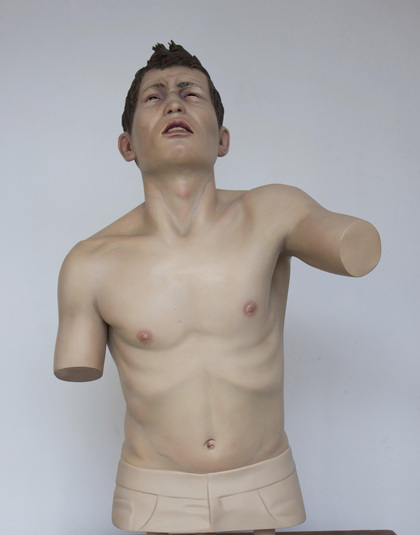-
From Current Issue
-
- Editor’s Letter Fire in the Heart
- Reviews I Gusti Ayu Kadek Murniasih
- Reviews 11th Seoul Mediacity Biennale: “One Escape at a Time”
- Dispatch Networked China
- One on One Monira Al Qadiri on Yukio Mishima
- Essays The rise of independent art spaces in pandemic-era Shanghai
- Features Tuan Andrew Nguyen
- Table of Contents
- Web Exclusives
- Archive
- Subscribe

R
E
V N
E
X
T
Installation view of REZA ARAMESH’s “12 Noon, Monday 5 August, 1963” at Asia Society Museum, New York, 2019. Copyright Bruce M. White. Courtesy Asia Society.
On Monday, August 5, 1963, the first nuclear weapons test ban treaty was signed by the United States, the United Kingdom, and the Soviet Union in Moscow. As part of the title of Reza Aramesh’s first solo museum presentation in the US, it is safe to assume that the date also marks a moment when some politically fueled atrocity was committed on a male body by another male body. Occupying a dimly lit room on the second floor of New York’s Asia Society Museum, “12 Noon, Monday 5 August 1963” showcased four sculptures from the artist’s “Action” series, where acts of male-on-male violence in situations of war or conflict—specified to the date in the artwork titles—are rendered in lifelike limewood sculptures.
Arranged in the middle of the room, Aramesh’s armless figures appear to orbit an invisible center, as if turned to stone while in the throes of a sacred orgasmic or sacrificial ritual. The dichotomies between ecstasy and suffering, pleasure and pain, seem to dissolve in their expressions. Their eyes are heavy; their porcelain-like faces, convulsed in agony or climax, looking upwards, begging for salvation or release. Smooth and glistening, their bodies are draped from the waist down in heavy, brown velvet that collapses onto the floor in excess. What little they are wearing hangs loosely off their shoulders, leaving their chests bare, and pinkish-brown nipples protruding.
Each sculpture’s title contains an “Action” number, a date, and in three cases, a location—details culled from the artist’s vast database of broadcast scenes depicting global human suffering, from the 1960s in Vietnam to the 2000s in Turkey. The vague specificity of each title adds little direction to the event that the sculpture is referencing, and it doesn’t have to, if the artist’s intention is to depict this violence as a universal condition, regardless of where, when, or on whom it was committed. But this notion is complicated by certain clues Aramesh has left us. For example, while the sculptures look racially ambiguous, the titles reveal that the nameless subjects are primarily non-European. Further, the room’s tiled wallpaper, plastered from floor to ceiling and evoking a regal Baroque interior, is in a pale green hue known as eau de Nil (“water of the Nile”). It was selected by the artist for its popular decorative usage in 19th century colonial homes, perhaps designating imperialist conquest as a main culprit in the violence perpetrated throughout much of the non-Western world to this day. A closer look at the wallpaper reveals a diamond-shaped pattern of nude male bodies surrounding a familiar image of a robed man with a hood over his head, awaiting execution.
The body of work on display, produced in 2013, was inspired by an exhibition of 17th century Spanish art that the artist saw at the National Gallery in London in 2009. There are clear references to those depictions of saints and martyrs that one would encounter in a Spanish church, from the figures’ tortured visages to Aramesh’s choice of sculpting with wood. The craft-like kitsch-ness of the limbless statues makes them look as if they were teleported straight out of an old church from a small, touristic European town, though the jarringly gelled hair sported by some snatches them back to the present.
Yet the suffering of Aramesh’s figures is conflated with homoeroticism—they are unabashedly sensual embodiments of male vulnerability. This perhaps attests to the subjugation of non-White male bodies through sexual humiliation, but it also achieves a more sinister effect. It is as if Aramesh is trying to implicate viewers in this referenced violence as witnesses or silent accomplices, standing by exploiting these yearning eyes, pleading lips, and muscular torsos with their predatory gaze. Or is this sexualization intended to decontextualize these bodies from a visual context we have all become accustomed and desensitized to—an escape from the trauma porn of embattled foreign territories so readily broadcast by Western media? Either way, sex sells. If only the figures’ chests were hairy.
Reza Aramesh’s “12 Noon, Monday 5 August, 1963” is on view at the Asia Society Museum, New York, until August 4, 2019.
To read more of ArtAsiaPacific’s articles, visit our Digital Library.

















